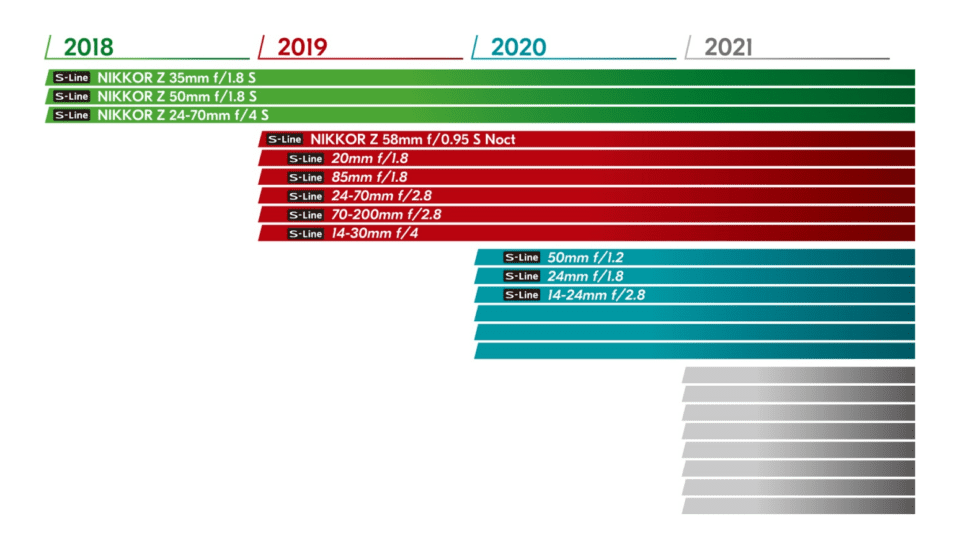It’s been almost three years since Nikon announced the Z mirrorless system in August of 2018. The initial Z6 and Z7 were accompanied by three lenses (24-70mm f/4, 35mm f/1.8, and 50mm f/1.8) as well as a roadmap which promised 20 more by the end of 2021. That’s about where we are today.
To put things into perspective, here’s the first roadmap announced alongside the early Z-series cameras, with a total of 23 lenses (eleven of which had no identifying information other than a placeholder):

This plan shuffled around a bit (the 70-200mm f/2.8 and 20mm f/1.8 shipping later than planned; the 24mm f/1.8 shipping earlier) but Nikon largely stuck to the script. So far, 20 Nikon Z lenses plus two teleconverters are shipping already, and it looks like Nikon will indeed hit the 23 lens mark by the end of 2021.
Here’s how the most current Nikon Z roadmap looks:

Although the current version of the roadmap looks very different from the original, it’s been basically the same for the past year or so. Occasionally, Nikon will release a new development announcement (like for the 18-140mm f/3.5-6.3 DX) and add it to the roadmap. But Nikon hasn’t added a large batch of lenses to the list for a while, and that means we’re filling out the roadmap faster than it’s expanding.
In the image above, Nikon labels the following nine lenses as “to be announced”:
- 85mm S-line lens
- 400mm S-line lens
- 600mm S-line lens
- 28mm compact lens
- 40mm compact lens
- 24-105mm S-line lens
- 100-400mm S-line lens
- 200-600mm lens
- 18-140mm DX lens
But even that’s a bit of a stretch. Three of those lenses have already received a development announcement (the 28mm f/2.8, 40mm f/2, and 18-140mm f/3.5-6.3 DX), and one is practically shipping already – the 28mm f/2.8 in its “SE” (special edition) form when bought with the Nikon Zfc camera.
This leaves six lenses that are completely unannounced: an 85mm (presumably f/1.2), 400mm (presumably f/2.8), 600mm (presumably f/4), 24-105mm, 100-400mm, and 200-600mm. Unless Nikon starts pre-announcing a lot of new lenses, the roadmap in its current form will be essentially complete by the end of the year.

Where do we go from there? Nikon has historically liked to keep its cards close to its chest. When the Z series was originally announced, many photographers were surprised to see a roadmap published alongside at all. It’s quite possible that Nikon will stop maintaining the roadmap now that we’re near the end. It may not be updated at all, or we may only see some development announcements added here and there.
The alternative is that Nikon will take the end of the first-generation roadmap as motivation to create a new version with many more new lenses, just like they did when initially announcing the Z system. Although this probably isn’t as likely to happen, it’s what I think many Nikon faithful are hoping for. One of the most consistently popular articles on Photography Life these past few years has been our analysis of the Nikon Z roadmap. The roadmap is clearly generating interest and anticipation among Nikon shooters – and probably grabbing the attention of some non-Nikon photographers who are considering jumping to the system.
If Nikon does choose to announce another roadmap, these are the lenses I’m hearing requested the most in emails and our comments section (with rough focal lengths and maximum apertures):
- 70-200mm f/4
- 70-300mm f/4-6.3
- 14mm f/1.8
- 35mm f/1.2
- 135mm f/1.8
- 200mm f/4 macro
- 300mm f/2.8
- 24mm or wider tilt-shift lens
- Any fisheye lens
- Any PF telephoto lens
- 10-24mm DX
- Any DX prime lenses
- Fast DX zoom lenses
The Z system is getting to the point that the basic lens needs are nearly covered. What’s left is for Nikon to fill out some of the few remaining gaps (especially on the telephoto end) and then start working on niche lenses that will attract more specialized photographers to these cameras.
Nikon may not be planning to maintain a detailed roadmap forever, and while I hope they do, the real key hasn’t changed. If Nikon can keep producing high-quality mirrorless lenses at a fast enough pace, the Z system will continue to get more advanced and competitive over time.